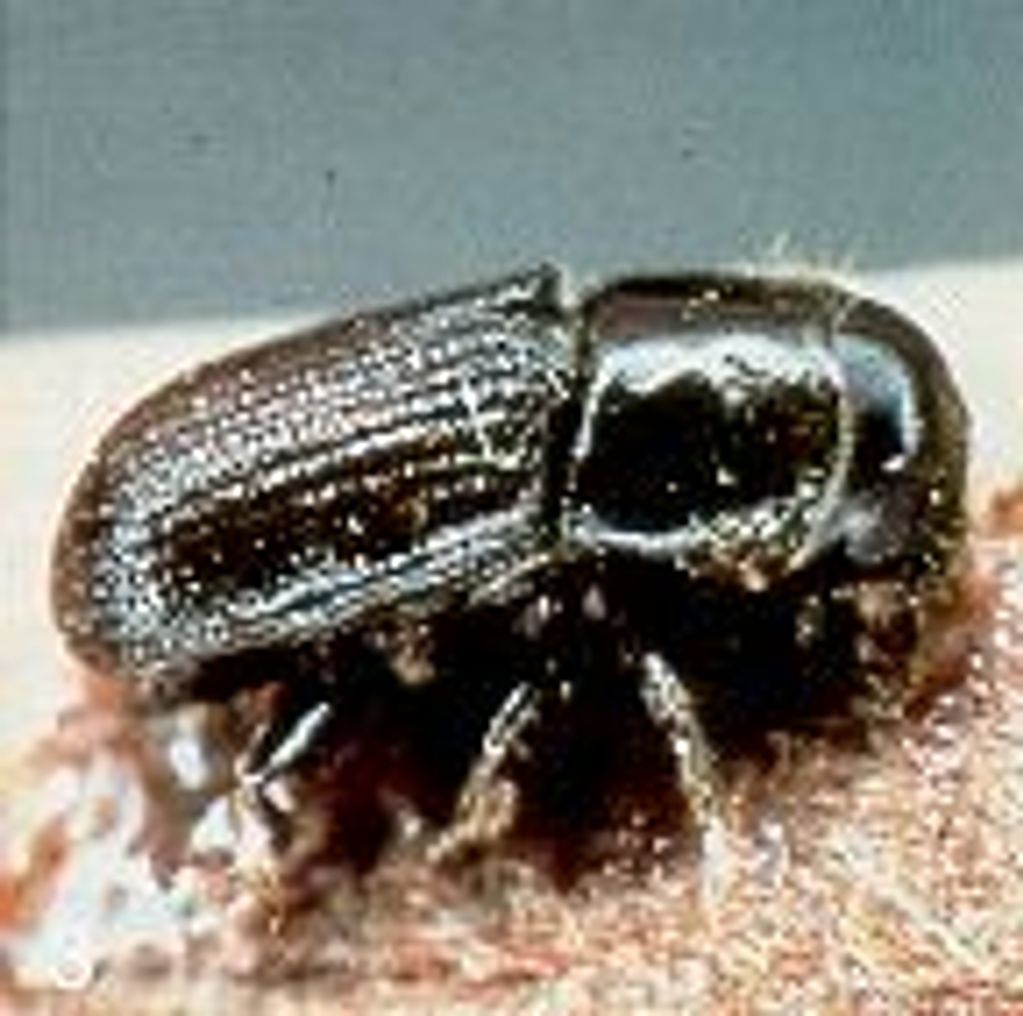southern pine beetle - pine tree killer
When you see signs of SPB in your forest - Act Fast!
Source: www.content.ces.ncsu.edu/southern-pine-beetle
Southern Pine Beetle Entomology Insect Notes
Southern pine beetles, Dendroctonus frontalis, are short-legged, stout, and about 1/8 inch long. The fore part of the head is notched, and the hind end of the body is rounded. Mature beetles are dark reddish-brown with slightly lighter wings. The egg is pearly white and just visible to the naked eye. The legless grubs grow to about 1/8 inch long and have glossy, reddish-brown heads and wrinkled, curved bodies. The pupa is delicate, white, and shaped somewhat intermediate between the grub and adult stages. Southern pine beetles become active in the spring about the time redbuds and dogwoods bloom. Pairs of southern pine beetles attack weakened and lightening damaged pine trees. If the tree has enough sap, a pitch tube forms at the entrance hole. The pitch tube is usually white and about the size of an average piece of pop corn. The beetles and their grubs feed on phloem tissue just under the bark. Females emit an aggregation pheromone that attracts males and more females to the tree. This pheromone, in conjunction with resin odors released by the attack points, attracts even more beetles to the tree.
From the first tree they may spread to stressed but otherwise healthy trees nearby. The beetles invade the tree's main stem and thousands of pairs may attack a single tree. They usually attack the middle and upper trunk first. Each pair excavates a winding serpentine tunnel about a foot long between the bark and wood. The tunnels crisscross to form an intricate pattern that girdles the tree. Eggs are deposited in niches along these tunnels. The larvae, usually feeding in the inner and outer bark, can be seen when the bark surface is whittled away with a hatchet. After a few weeks, the larvae change to pupae, and new adults emerge in a few more weeks. We have three to five generations per year. The last brood of the season overwinters in various stages of development under or in the bark of infested trees. During certain periods, these insects may become so numerous that they are able to kill entire stands of trees up to several hundred acres.
Host Plants
Southern yellow pines are the primary hosts of southern pine beetles, but they have been reported from red spruce and Norway spruce. Shortleaf, loblolly, Virginia, and pitch pines appear to be the preferred hosts in North Carolina. Southern pine beetles usually attack trees that are at least 15 years old. Trees infested by southern pine beetles sometimes pitch them out if growing conditions improve (that is, if it rains). Southern pine beetles introduce blue stain fungi (usually from the genera Ophiostoma. Grosmannia, and Ceratocystis) that plug up the water carrying vessels inside the tree.
The combination of stress that made the tree susceptible to the southern pine beetle, the beetles tunneling in the cambium, and the blue stain fungus is almost always fatal. It is especially damaging to stands of poor vigor. Outbreaks are often triggered by soil-moisture stresses and by man-caused disturbance. The first sign of an infestation is usually browning of needles that first yellow and then turn brownish orange to reddish-brown. Typically, pines are killed in groups ranging from a few trees to several hundred acres. Southern pine beetles may kill high-value trees in landscapes and parks.
Residential Recommendations
Spraying after a tree is infested with southern pine beetles has little practical effect. Little can be done as rescue treatments. Pines should be kept vigorous by mulching and watering in extremely dry weather (but NO fertilizer!). Don't injure the bark and avoid excessive grading around the roots or compaction of soil. Cut infested trees down just as soon as southern pine beetles are detected and debark or remove the the trees immediately. The application of protective sprays of pyrethroid insecticides for living trees is expensive but may be considered for valuable specimen trees.
Authors
Steven Frank
Professor and Extension Specialist
Entomology & Plant Pathology
James Baker
Professor Emeritus
Entomology & Plant Pathology
Stephen Bambara
Retired Extension Specialist (Home Ornamentals/Turf)
Entomology & Plant Pathology
===================
If you suspect Southern Pine Beetles have infested your timberland, don't procrastinate, act soon! Beetles have been known to kill hundreds, sometimes thousands of acres of pine in a single infestation. They don't just go away on their own. The best treatment - on a forest landholding scale - is to quickly harvest the infested trees along with a surrounding buffer of healthy stems. Fall Line Forestry can help - Contact Us

"Popcorn" balls on a Pine stem are one sign of Southern Pine Beetle infestation
southern pine beetle signs

Southern Pine Beetle - so small you're unlikely ever to see one - but you can see their impact!

Pine tree tops turning rapidly yellow, then red, then brown, then dead are indicative of Southern Pine Beetle

More popcorn balls

Southern Pine Beetle entry/exit holes may be small, but their damage is large

Sawdust at the base of a Pine tree is another Beetle sign

Harvest of beetle-infested timber, and a buffer of healthy trees surrounding, is the best treatment
Copyright © 2025 Fall Line Forestry - All Rights Reserved.
Forestry Consultants | Timberland Managers